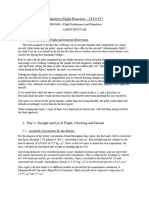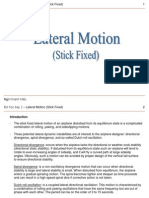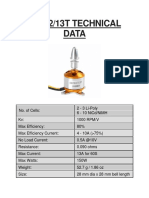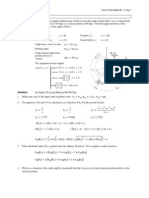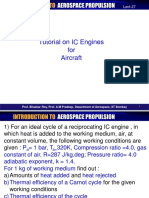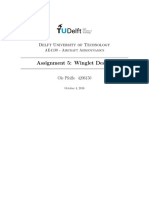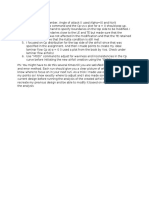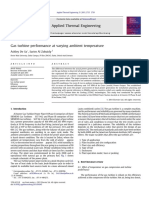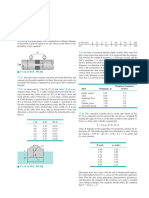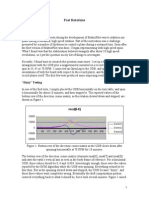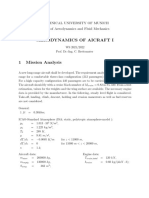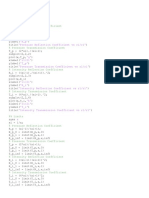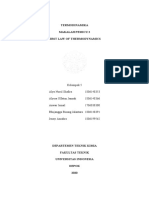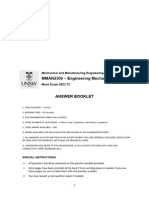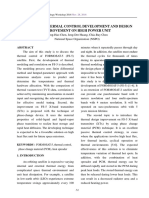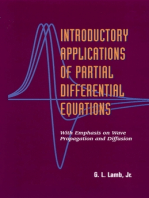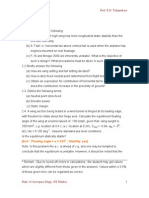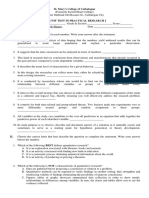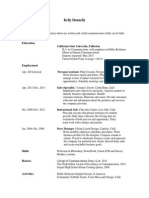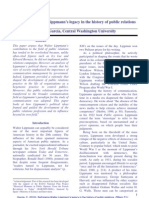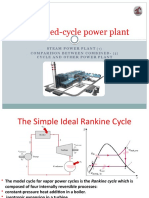012 - Chapter 2 - L10
012 - Chapter 2 - L10
Uploaded by
nanduslns07Copyright:
Available Formats
012 - Chapter 2 - L10
012 - Chapter 2 - L10
Uploaded by
nanduslns07Original Title
Copyright
Available Formats
Share this document
Did you find this document useful?
Is this content inappropriate?
Copyright:
Available Formats
012 - Chapter 2 - L10
012 - Chapter 2 - L10
Uploaded by
nanduslns07Copyright:
Available Formats
Flight dynamics II Prof. E.G.
Tulapurkara
Stability and control
Dept. of Aerospace Engg., IIT Madras 1
Chapter 2
Longitudinal stickfixed static stability and control
Lecture 10
Topics
Example 2.5
Example 2.6
2.12 Longitudinal control
2.12.1 Elevator power
2.12.2 Control effectiveness parameter ()
2.12.3 Elevator angle for trim
2.12.4 Advantages and disadvantages of canard configuration
2.12.5 Limitations on forward movement of c.g. in free flight
2.12.6 Limitations on forward movement of c.g. in proximity of ground
Example 2.5
A sailplane has the following characteristics. C
D
= 0.02 + 0.025 C
L
2
,
C
Lw
= 0.093,
0Lw
= - 4, i
w
= 0, a.c. location = 0.24 c , S
t
= S / 7, l
t
= 4 c ,
= 0.4, C
Lt
= 0.05 and = 0.9. All the angles are in degrees. Neglect the
contribution of fuselage. Find the c.g. location for which the equilibrium is
reached with zero lift on the tail at the lift coefficient corresponding to the best
guiding angle. Calculate the tail setting. Is the sailplane stable?
Solution:
The airplane prescribed in this exercise is a sailplane. A sailplane is a high
performance glider. There is no power plant in a glider. Further, the contribution
of fuselage is prescribed as negligible. Hence, the terms (C
mcg
)
f,n,p
and (C
m
)
f,n,p
are zero in the present case.
The given data is as follows.
C
D
= C
D0
+ KC
L
2
= 0.02 + 0.025 C
L
2
Flight dynamics II Prof. E.G. Tulapurkara
Stability and control
Dept. of Aerospace Engg., IIT Madras 2
Wing: C
Lw
= 0.093 (
w
+4), C
Lw
= 0.093 deg
-1
= 5.329rad
-1
, C
mac
= -0.08, i
w
= 0,
a.c. at 0.24 c .
Tail: S
t
= S / 7, = 0.4 or d/d = 0.4, = 0.9, C
Lt
= 0.05 deg
-1
= 2.865 rad
-1
.
For the best gliding angle (C
D
/C
L
) should be minimum.
This happens when C
L
= C
Lmd
Lmd D0
and C = C / K
In the present case C
Lmd
= 0.02/ 0.025 0.895 =
When the airplane is flying at C
L
= C
Lmd
, the lift on tail is prescribe to be zero or
t
= 0.
Now,
t
=
w
- i
w
+ i
t
,
At C
L
= C
Lmd
,
w
= (0.895/ 0.093) - 4 = 5.62
0
, = 0.4 = 0.4 (
w
- i
w
)
At C
L
= C
Lmd
, = 0.4 (5.62 - 0) = 2.25
0
Since,
t
is zero at C
L
= C
Lmd,
gives the following result.
0 = 5.62 - 2.25 + i
t
or i
t
= - 3.37
0
To examine static stability, the quantity (C
m
)
stick-fix
is calculated. It is noted that:
C
mcg
= C
m0
+ C
m
cg
ac
mcg mac Lw mcg f,n,p mcgt
cg
ac
m stick-fix Lw m f,n,p H Lt
x
x
C = C + C ( - )+(C ) + C
c c
x
x d
(C ) = C ( - )+(C ) -V C (1- )
d c c
To evaluate the expression for C
m
the quantity
cg
ac
x
x
( - )
c c
is needed. This can be
obtained using the following steps.
When the airplane is flying at C
L
= C
Lmd
, the contributions of tail, fuselage,
nacelle and power are zero. Hence, the expression for C
mcg
reduces to
cg
ac
mcg Lw mac
x
x
C = C ( - ) + C
c c
For equilibrium C
mcg
must be zero at C
Lmd
i.e. :
Flight dynamics II Prof. E.G. Tulapurkara
Stability and control
Dept. of Aerospace Engg., IIT Madras 3
cg
ac
cg
ac
cg
x
x
0 = 0.895( - ) - 0.08
c c
x
x 0.08
- = = 0.089
0.895 c c
x
or = 24+ 0.089 = 0.329
c
t
H
S
Further, V =
S
4
=
c 7
t
l
m
-1
4
Finally, C = 5.329(0.329-0.24)-0.9 2.865(1-0.4)
7
= 0.47428-0.88406 = -0.4098 rad
C
m
is negative and hence the sailplane is stable.
Example 2.6
The contribution of wing fuselage combination to the moment about the
c.g. of an airplane is given below.
C
L
0.28 0.488 0.696 0.9
(C
mcg
)
w,f
- 0.0216 - 0.006 0.0064 0.0156
(i) If the wing loading is 850 N/m
2
, find the flight velocity at sea level when the
airplane is in trim with zero lift on the tail. (ii) Investigate the stability of the
airplane with the following additional data: C
Lw
= 0.08 deg
-1
, C
Lt
= 0.072 deg
-1
,
d/d = 0.45 , l
t
= 2.9 c , S
t
= S/7, =1.0. Assume the contributions of power to
C
mcg
and
o m
C to be negligible.
Solution:
i) To answer the first part, the value of C
L
at which the airplane is in trim with zero
lift on tail needs to be obtained. In this case:
C
mcg
= (C
mcg
)
w,f
= 0
The prescribed variation of (C
mcg
)
w,f
with C
L
is slightly non-linear. Hence, the
given data are plotted and the value of C
L
at which (C
mcg
)
w,f
is zero is obtained
from the plot. The plot is shown in Fig. E2.6. When (C
m
)
w,f
is zero, C
L
equals
0.585 .
Flight dynamics II Prof. E.G. Tulapurkara
Stability and control
Dept. of Aerospace Engg., IIT Madras 4
In level flight: L = W = V
2
SC
L
L
or V = 2W/SC
Substituting various values, the desired velocity is:
2850
-1
V = = 48.7ms
1.2250.585
ii) To examine the static stability C
m
needs to be calculated.
Fig.E2.6 (C
mcg
)
w,f
vs C
L
m
m L w w,f H L t
L
L w L t H
dC d
C = C ( ) - V C (1- )
dC d
1
C = 0.08,C = 0.072, V = 2.9 = 0.414
7
d
= 0.45
d
From graph in Fig.E2.6 at C
L
= 0.585 we obtain, the slope of the curve as:
-0.025
-0.02
-0.015
-0.01
-0.005
0
0.005
0.01
0.015
0.02
0 0.2 0.4 0.6 0.8 1
(C
mcg
)
w,f
C
L
Flight dynamics II Prof. E.G. Tulapurkara
Stability and control
Dept. of Aerospace Engg., IIT Madras 5
m L w,f
m
-1
(dC /dC ) = 0.0615
Hence, C = 0.08 57.3 0.0615 - 0.414 1 0.072 57.3 (1- 0.45)
= 0.2819 - 0.9394 = - 0.6575 rad
Since, C
m
is negative the airplane is stable.
2.12 Longitudinal control
An airplane is said to be trimmed at a given flight speed and altitude, when
the moments are made zero by suitable deflection of control surfaces. For the
longitudinal motion, the trim or C
mcg
= 0 is achieved by suitable deflection of
elevator. The convention regarding the elevator deflection is that a downward
deflection of elevator is taken as positive (Fig.2.16b). For the conventional tail
configuration, this deflection increases lift on tail and produces a negative
moment about c.g..
Let C
L
and C
mcg
be the incremental lift and pitching moment due to the
elevator deflection i.e.
c
c
L
L Lt Le e Le
e
C
C = C = C ; C =
(2.72)
mcg
mcg mcgt me e me
e
C
C = C = C ; C =
c
c
(2.73)
Hence, when the elevator is deflected, the lift coefficient (C
L
) and moment
coefficient about c.g. (C
mcg
) for the airplane are :
L L 0L Le e
C = C (- ) + C (2.74)
mcg m0 m me e
C = C + C + C (2.75)
Where C
L
, C
L
and
0L
refer respectively to the lift coefficient, slope of the lift
curve and zero lift angle of the airplane.
Note: In this section C
m
will mean (C
m
)
stick-fixed
.
2.12.1 Elevator power (C
me
)
The quantity C
me
is called elevator power. An expression for it has been
hinted in Eq.(2.64). It can be derived as follows.
Let, L
e
be the change in the airplane lift due to elevator deflection which is also
the change in the lift of the horizontal tail i.e.
Flight dynamics II Prof. E.G. Tulapurkara
Stability and control
Dept. of Aerospace Engg., IIT Madras 6
2
e t e t t Lt e
1
L = (L ) = V S (C )
2
c
c
e t t Lt
Le Lt e e
2
e
L S S C
C = = (C ) =
1
S S
V S
2
(2.76)
Hence,
c c
c c
t Lt L
Le
e e
S C C
=C =
S
(2.77)
2
e e t t t Lt e t
2
t
e t t
me Lt e
2 2
Lt
me H Lt e H e
e
1
M = L = V S (C )
2
1
V
M S
2
C = = (C )
1 1
S c
V Sc V
2 2
C
Or C = -V (C ) = -V
l l
l
c
c
;
t
L
m
me H H Lt Le Lt
e e
C
C
Hence, = C = - V = - V C = C /C
t t
c
c
c c
(2.78)
2.12.2 Control effectiveness parameter (t)
The quantity t is called elevator effectiveness parameter. The value of t
depends on the geometrical parameters of the tail and the elevator. However, it
mainly depends on (S
e
/ S
t
) where S
e
is the area of the elevator. References
1.12 and 2.2 give a detailed procedure for estimating it. However, Fig.2.32 can
be used for an initial estimate.
Flight dynamics II Prof. E.G. Tulapurkara
Stability and control
Dept. of Aerospace Engg., IIT Madras 7
Fig.2.32 Control effectiveness parameter
(Reproduced from Refs.1.1, chapter 2 with permission from
McGraw-Hill book company)
2.12.3 Elevator angle for trim
The following steps are followed to get the elevator angle for trim (
etrim
).
From Eq. (2.75)
mcg m0 m me e
C = C +C +C
For trim C
mcg
= 0.
Hence,
m0 m trim me trim
0 = C + C + C
Or
trim m0 m trim
me
-1
= [C + C ]
C
(2.79)
From Eq.(2.74)
Ltrim L trim 0L Le trim
C = C ( - ) + C (2.80)
Or
trim
=
Ltrim Le trim L 0L
L
1
{C - C + C }
C
Hence,
m
trim m0 Ltrim Le trim L 0L
me L
C -1
= [C + {C - C + C }]
C C
(2.81)
m0 L m Ltrim L 0L m Le trim
me trim
L
[C C + C (C +C ) - C C ]
Or C = -
C
Flight dynamics II Prof. E.G. Tulapurkara
Stability and control
Dept. of Aerospace Engg., IIT Madras 8
Simplifying,
L m0 m 0L m Ltrim
trim
me L m Le
[C (C + C ) + C C ]
= -
[C C - C C ]
(2.82)
Differentiating with C
L
,
trim m
Ltrim me L m Le
d C
= -
dC [C C -C C ]
(2.83)
Following may be noted.
(i) The quantities C
me
, C
L
and C
Le
depend on the airplane geometry. Further,
for a given c.g. location, C
m
is also known and hence the term (d
etrim
/dC
Ltrim
) in
Eq.(2.83) is a constant. Hence, in the simplified analysis being followed here, it is
observed that for a given c.g. location
trim
is a linear function of C
L
. Further the
term C C
m Le
is much smaller than C
me
C
L
. Consequently,
trim
as a function
of C
L
can be written as:
m
trim eoCL stick-fixed L
me L
dC 1
= - ( ) C
C dC
(2.84)
where,
L m0 m 0L
e0CL
me L m Le
C (C + C )
= -
[C C -C C ]
Similarly, using Eq.(2.79),
trim
as a function of
trim
can be expressed as:
m0 m
trim trim
me me
C C
= - -
C C
(2.85)
Typical curves for the variations of
trim
with C
L
are shown in Fig.2.33 for different
locations of c.g.. From Eq.(2.85) it is seen that at C
L
= 0 the value of
trim
is
positive as C
m0
is positive and C
me
is negative. For a stable airplane
(dC
m
/dC
L
)
stick-fixed
is negative and hence the slope of
trim
vrs C
L
curve is
negative.
Flight dynamics II Prof. E.G. Tulapurkara
Stability and control
Dept. of Aerospace Engg., IIT Madras 9
Fig.2.33 Elevator angle for trim
(ii) In light of the above analysis, consider a case when the airplane is trimmed at
a chosen C
L
by setting the elevator at corresponding
trim.
Now, if the pilot wishes
to fly at a lower speed which implies higher C
L
, he would need to apply more
negative elevator deflection or the incremental lift on the tail ( )
t
L A would be
negative. This is what is implied when in section 2.4.1 it is mentioned that for
achieving equilibrium with conventional tail configuration, the lift on the tail is
generally in the downward direction. An alternate explanation is as follows.
When the pilot wishes to increase the angle of attack by o A , a statically stable
airplane produces a moment
cg
- M .To counterbalance this moment, the elevator
must produce
cg
M + . This requires A
t
L and inturn o A
e
.
(iii) Military airplanes which are highly maneuverable, sometimes have the
following features.
Flight dynamics II Prof. E.G. Tulapurkara
Stability and control
Dept. of Aerospace Engg., IIT Madras 10
(a) An all movable tail in which the entire horizontal tail is rotated to achieve
higher
cg
M . (b) Relaxed static stability wherein
m
C may have a small positive
value. Such airplanes need automatic control (section 10.3). See section 6.1 of
Ref.1.13 for further details.
2.12.4 Advantages and disadvantages of canard configuration
In light of the above discussion the advantages and disadvantages of the
canard configuration can now be appreciated.
Advantages:
(a) The flow past canard is relatively free from wing or engine interference.
(b) For an airplane with C
m
< 0, the lift on the horizontal stabilizer located behind
the wing (i.e. conventional configuration) is negative when the angle of attack
increases. Thus, for a conventional tail configuration, the wing is required to
produce lift which is more than the weight of the airplane. If the surface for
control of pitch, is ahead of the wing (canard), the lift on such horizontal control
surface is positive and the lift produced by the wing equals the weight of the
airplane minus the lift on canard. Thus, the wing size can be smaller in a canard
configuration.
Disadvantages:
(a) The contribution of the canard to C
m
is positive i.e. destabilizing.
(b) As the wing, in this case, is located relatively aft, the c.g. of the airplane
moves aft and consequently the moment arm for the vertical tail is small.
Topics for self study:
1. From Ref.2.3 study the airplanes with canard and obtain rough estimates
of (S
t
/ S) and (l
t
/ c). Two examples of airplanes where canard is used are
SAAB Viggen and X-29A.
2.12.5 Limitations on forward moment of c.g. in free flight
As the c.g. moves forward, the airplane becomes more stable and hence
requires larger elevator deflection for trim at a chosen C
L
. It is seen that as C
L
increases, more negative elevator deflection is required (Fig. 2.33). Further, each
airplane has a value of C
Lmax
which depends on the parameters of the wing.
However, equilibrium at C
Lmax
can be achieved only if the airplane can be
Flight dynamics II Prof. E.G. Tulapurkara
Stability and control
Dept. of Aerospace Engg., IIT Madras 11
trimmed at this lift coefficient. Further, the maximum elevator deflection is limited
to approximately about 25
0
(negative). Hence, there would be a forward c.g.
location at which the maximum negative elevator deflection would be just able to
permit trim at C
Lmax
. This brings about a limitation on the forward movement of
c.g. from control consideration. It may be recalled that the rearword movement of
c.g. is limited by the stability consideration.
2.12.6 Limitations on forward movement of c.g in proximity of ground
As the airplane comes in to land, the lift coefficient is generally the
highest. It is achieved using flaps and this makes C
macw
more negative. Further,
due to the proximity of ground, following changes in
Lw
C and ( ) d / d are
observed.
(a) The slope of lift curve of the wing, i.e. C
Lw
increases slightly. The actual
amount of increase in C
Lw
depends on the ratio of the height of the wing above
the ground and its span (see Ref.1.7, chapter 5). There is no significant change
in C
Lt
.
(b) The downwash due to wing decreases considerably (Fig.2.12) and
consequently the tail contribution to stability (C
mt
) becomes more negative
(Eq.2.50) or the airplane becomes more stable.
The net effect is that the airplane requires more negative elevator
deflection. This imposes further restrictions on the forward movement of c.g..
Figure 2.34 shows the restrictions on c.g. travel based on factors discussed so
for. Additional restrictions on the movement of c.g. would be pointed out after
discussions in chapters 3 and 4.
Flight dynamics II Prof. E.G. Tulapurkara
Stability and control
Dept. of Aerospace Engg., IIT Madras 12
Fig.2.34 Restrictions on c.g. movement from stick fixed stability and control
considerations (schematic)
You might also like
- Modern Adaptation of Prandtl's Classic Lifting-Line Theory: Utah State University, Logan, Utah 84322-4130Document9 pagesModern Adaptation of Prandtl's Classic Lifting-Line Theory: Utah State University, Logan, Utah 84322-4130Ibraheem AlQadiNo ratings yet
- Z5311577 - Aero3660 - Bankstown Flight Excercise - Aaron HoytashDocument17 pagesZ5311577 - Aero3660 - Bankstown Flight Excercise - Aaron HoytashAaron HoytashNo ratings yet
- Drag Polar Assignment - Nathan Cook P4096835Document9 pagesDrag Polar Assignment - Nathan Cook P4096835Anonymous 2iMBk59NXLNo ratings yet
- QUBE-Servo Inverted Pendulum ModelingDocument4 pagesQUBE-Servo Inverted Pendulum ModelingByron Xavier Lima CedilloNo ratings yet
- Uob FormDocument1 pageUob FormBenjamin YeoNo ratings yet
- Analytical Determination of Radial Inflow Turbine Design Geometry For Maximum Efficiency by RohlikDocument39 pagesAnalytical Determination of Radial Inflow Turbine Design Geometry For Maximum Efficiency by RohlikSyed Jiaul HoqueNo ratings yet
- AEEC432 Rectilinear ControlDocument46 pagesAEEC432 Rectilinear ControlMelina Andrea ZiccorNo ratings yet
- Bài 5 - Lateral Motion (Stick Fixed) (2008)Document12 pagesBài 5 - Lateral Motion (Stick Fixed) (2008)neiht_ksNo ratings yet
- Flight Dynamics ProjectDocument26 pagesFlight Dynamics ProjectShatha SivamNo ratings yet
- BLDC A2212 13T PDFDocument4 pagesBLDC A2212 13T PDFMuhamad Giga RumanovNo ratings yet
- Cat ScorecardDocument1 pageCat ScorecardasishNo ratings yet
- LearnCAx Tutorial CFD 01 2015 CFD Simulation of Backward Facing Step ProblemDocument30 pagesLearnCAx Tutorial CFD 01 2015 CFD Simulation of Backward Facing Step ProblemRyan Goh Chuang HongNo ratings yet
- Aerodynamics ExercicesDocument5 pagesAerodynamics ExercicesMarcRosetNo ratings yet
- Static Stability and Control - Elevator Control Power, Elevator Angle To Trim and Estimation of Stick Fixed Neutral PointDocument5 pagesStatic Stability and Control - Elevator Control Power, Elevator Angle To Trim and Estimation of Stick Fixed Neutral PointgavinNo ratings yet
- Direct and Inverse Kinematics of Stewart Platform Applied To Offshore Cargo Transfer SimulationDocument7 pagesDirect and Inverse Kinematics of Stewart Platform Applied To Offshore Cargo Transfer SimulationMuebles SanabriaNo ratings yet
- The Lift and Drag of A WingDocument9 pagesThe Lift and Drag of A WingRaphael EfstathiouNo ratings yet
- DESIGN OF MACHINERY - Problem 4-18gDocument2 pagesDESIGN OF MACHINERY - Problem 4-18gGiordano VieiraNo ratings yet
- Conceptual DesignDocument28 pagesConceptual DesignDaniel JaimiNo ratings yet
- Propulsion and Power Formula SheetDocument4 pagesPropulsion and Power Formula SheetArun VinthanNo ratings yet
- Propulsion Homework Exercises A 12-08Document11 pagesPropulsion Homework Exercises A 12-08jgolloberNo ratings yet
- Rr312102 Aircraft PerformanceDocument8 pagesRr312102 Aircraft PerformanceSrinivasa Rao GNo ratings yet
- Turbulence ModelsDocument5 pagesTurbulence Modelsashoku2100% (1)
- Small Perturbation TheoryDocument4 pagesSmall Perturbation TheoryviviyanissacNo ratings yet
- Lec27 Problem Solution PDFDocument22 pagesLec27 Problem Solution PDFmaya singhNo ratings yet
- The Realization of Virtual Reality of Launching Rocket Based On Simulink and VRMLDocument4 pagesThe Realization of Virtual Reality of Launching Rocket Based On Simulink and VRMLIJEC_EditorNo ratings yet
- Assignment 5Document14 pagesAssignment 5OleNo ratings yet
- Power Requirements of A VehicleDocument32 pagesPower Requirements of A VehicleAvinashRaiNo ratings yet
- Thin Aerofoil Theory NotesDocument25 pagesThin Aerofoil Theory Notessasiaero100% (1)
- Computational Aerodynamics of Hovering Helicopter Rotors: Jurnal Mekanikal June 2012 No 34, 16-46Document31 pagesComputational Aerodynamics of Hovering Helicopter Rotors: Jurnal Mekanikal June 2012 No 34, 16-46Peter IjaramendiNo ratings yet
- Objective Type Questions Instrumentation System & Devices (IDS)Document7 pagesObjective Type Questions Instrumentation System & Devices (IDS)mail2jaleel9952No ratings yet
- Two Spool Turbofan Low Bypass Engine StudyDocument35 pagesTwo Spool Turbofan Low Bypass Engine StudysaurabhNo ratings yet
- Numerical Analysis of Aerodynamic Performance Characteristics of NACA 2312 and NACA 2412Document9 pagesNumerical Analysis of Aerodynamic Performance Characteristics of NACA 2312 and NACA 2412International Journal of Innovative Science and Research TechnologyNo ratings yet
- Xfoil Mdes TutorialDocument1 pageXfoil Mdes TutorialOzichukwu OsakweNo ratings yet
- Wind Tunnel Calibration MemoDocument5 pagesWind Tunnel Calibration Memoapi-512393144No ratings yet
- Introduction To The Method of Characteristics and The Minimum Length NozzleDocument52 pagesIntroduction To The Method of Characteristics and The Minimum Length Nozzledurgesh3guptaNo ratings yet
- Question Bank AerodynamicDocument7 pagesQuestion Bank AerodynamicAjay DeshmukhNo ratings yet
- Desa2011 PDFDocument5 pagesDesa2011 PDFTayyabIsmailNo ratings yet
- Blasius Equation Numerical SolutionDocument4 pagesBlasius Equation Numerical SolutionTinhNo ratings yet
- Stability Augmentation SystemsDocument4 pagesStability Augmentation SystemsSuraj ChaurasiyaNo ratings yet
- FVTD - Iit BombayDocument88 pagesFVTD - Iit BombayanubhavNo ratings yet
- H141Document19 pagesH141AleksandarNo ratings yet
- L-12 (SS) (Ia&c) ( (Ee) Nptel) - P-I-D ControlDocument10 pagesL-12 (SS) (Ia&c) ( (Ee) Nptel) - P-I-D ControlRaymond EsmeraldaNo ratings yet
- Time-Dependent MethodsDocument12 pagesTime-Dependent MethodsmanrezaNo ratings yet
- FIGURE P7.30: (A) Use Dimensional Analysis With The Assumption That The WingbeatDocument6 pagesFIGURE P7.30: (A) Use Dimensional Analysis With The Assumption That The Wingbeatmohamed ahmedNo ratings yet
- Fast RotationsDocument14 pagesFast RotationsshashankifNo ratings yet
- Aerodynamics of Aicraft I: Technical University of Munich Chair of Aerodynamics and Fluid MechanicsDocument5 pagesAerodynamics of Aicraft I: Technical University of Munich Chair of Aerodynamics and Fluid MechanicskakaNo ratings yet
- Chapter 5 - Launch Vehicle Guidance Present Scenario and Future TrendsDocument20 pagesChapter 5 - Launch Vehicle Guidance Present Scenario and Future TrendsAdrian ToaderNo ratings yet
- Aerodynamics II Lecture NotesDocument17 pagesAerodynamics II Lecture NotesSuman.S100% (1)
- 'R' 'r1/21' 'R - P' 'Pressure Reflection Coefficient Vs r1/r1'Document4 pages'R' 'r1/21' 'R - P' 'Pressure Reflection Coefficient Vs r1/r1'Adam FoltzNo ratings yet
- Makalah Pemicu 2 Kelompok 5Document17 pagesMakalah Pemicu 2 Kelompok 5Bhujangga binangjNo ratings yet
- MMAN2300 Mock Exam QS 1Document15 pagesMMAN2300 Mock Exam QS 1Aaron HoytashNo ratings yet
- CFD Analysis of Two-Bucket Savonius Rotor Using Fluent PackageDocument7 pagesCFD Analysis of Two-Bucket Savonius Rotor Using Fluent PackageAlireza Ab100% (1)
- Formsat 5Document6 pagesFormsat 5gramuiitmNo ratings yet
- Nonlinear Lifting LineDocument94 pagesNonlinear Lifting LineAnonymous gxAd4liNo ratings yet
- MS T F2sdaadssdDocument50 pagesMS T F2sdaadssdarthur baggioNo ratings yet
- Matlab Project Section B1Document50 pagesMatlab Project Section B1Biruk TadesseNo ratings yet
- Damage Mechanics in Metal Forming: Advanced Modeling and Numerical SimulationFrom EverandDamage Mechanics in Metal Forming: Advanced Modeling and Numerical SimulationRating: 4 out of 5 stars4/5 (1)
- Introductory Applications of Partial Differential Equations: With Emphasis on Wave Propagation and DiffusionFrom EverandIntroductory Applications of Partial Differential Equations: With Emphasis on Wave Propagation and DiffusionNo ratings yet
- Longitudinal Stick-Fixed Static Stability and Control TopicsDocument12 pagesLongitudinal Stick-Fixed Static Stability and Control Topicssameh hassanNo ratings yet
- Aircraft Performance TulapurkaraDocument6 pagesAircraft Performance TulapurkaraKISHORKUMAR UKIRDENo ratings yet
- 015 Chapter 2 ExercisesDocument5 pages015 Chapter 2 Exercisesnanduslns07No ratings yet
- Single Horseshoe Vortex Wing Model: B V S V L CDocument4 pagesSingle Horseshoe Vortex Wing Model: B V S V L Cnanduslns07No ratings yet
- M C C M C C: Similarity in Wind Tunnel TestingDocument3 pagesM C C M C C: Similarity in Wind Tunnel Testingnanduslns07No ratings yet
- Y V X U X P P y P: Solutions of The Laminar Boundary Layer EquationsDocument2 pagesY V X U X P P y P: Solutions of The Laminar Boundary Layer Equationsnanduslns07No ratings yet
- Poiseuille Flow Through A Duct in 2-DDocument4 pagesPoiseuille Flow Through A Duct in 2-Dnanduslns07No ratings yet
- Laminar Boundary Layer Order of Magnitude Analysis: DirectionDocument3 pagesLaminar Boundary Layer Order of Magnitude Analysis: Directionnanduslns07No ratings yet
- Effect of Turbulent Fluctuations On Mean Flow: Reynolds-AveragingDocument3 pagesEffect of Turbulent Fluctuations On Mean Flow: Reynolds-Averagingnanduslns07No ratings yet
- K KX X U: Falkner-Skan FlowsDocument3 pagesK KX X U: Falkner-Skan Flowsnanduslns07No ratings yet
- U U U X X X U U V W V X X y Z: Viscous Flow: Stress Strain RelationshipDocument2 pagesU U U X X X U U V W V X X y Z: Viscous Flow: Stress Strain Relationshipnanduslns07No ratings yet
- Integral Boundary Layer Equations: U Dy U DyDocument5 pagesIntegral Boundary Layer Equations: U Dy U Dynanduslns07No ratings yet
- Introduction - 3 Topics: Flight Dynamics - II Prof. E.G. Tulapurkara Stability and ControlDocument8 pagesIntroduction - 3 Topics: Flight Dynamics - II Prof. E.G. Tulapurkara Stability and Controlnanduslns07No ratings yet
- DDocument4 pagesDDayhen Afable BianesNo ratings yet
- New ResumeDocument1 pageNew Resumeapi-258549600No ratings yet
- How To Use MelEye - DemoDocument2 pagesHow To Use MelEye - DemoFauzan RezaNo ratings yet
- Mat. Ocasionales 12.05.2021Document40 pagesMat. Ocasionales 12.05.2021Carlos Eugenio Lovera VelasquezNo ratings yet
- 2017 Directory of China's Coal-to-Gas Projects PDFDocument2 pages2017 Directory of China's Coal-to-Gas Projects PDFarapublicationNo ratings yet
- Gamification: January 2015Document10 pagesGamification: January 2015najjahul imtihanNo ratings yet
- UCPB BIR EFPS Quick Guide - One Pager - AO2013-0118Document1 pageUCPB BIR EFPS Quick Guide - One Pager - AO2013-0118Noel Remolacio100% (1)
- Aerobic Digestion Pre LabDocument10 pagesAerobic Digestion Pre Labmuhammad ibrahimovicNo ratings yet
- Low CSSR ExplainationDocument4 pagesLow CSSR ExplainationJamal StevensNo ratings yet
- Graduate Thesis ProposalsDocument2 pagesGraduate Thesis ProposalsCaselyn CammagayNo ratings yet
- 365B L Your Working Advantage (AEDC0603-01)Document12 pages365B L Your Working Advantage (AEDC0603-01)suwarjitechnicNo ratings yet
- Peak To Valley Ratio in ChromeleonDocument2 pagesPeak To Valley Ratio in ChromeleonDewi Wulandhari50% (2)
- 1516 Basiswissen Elektronik FAQ HELLA EN PDFDocument52 pages1516 Basiswissen Elektronik FAQ HELLA EN PDFfchyc_26975087No ratings yet
- GarciaDocument10 pagesGarciaMarco Toledo BastosNo ratings yet
- Fir Filters ReportDocument8 pagesFir Filters ReportGaneshVenkatachalam100% (1)
- Rodac RC3750+PartsDocument1 pageRodac RC3750+PartsFGarcia92No ratings yet
- Sathish ResumeDocument3 pagesSathish ResumeSantosh JakathiNo ratings yet
- Design and Engineering KTU Module-1Document15 pagesDesign and Engineering KTU Module-1Naseel Ibnu Azeez100% (1)
- ShotcreteDocument26 pagesShotcreteMohamed Nk100% (1)
- Combined Cycle Power PlantDocument14 pagesCombined Cycle Power PlantĐặng Trung Anh100% (1)
- List of Companies For CertificationDocument3 pagesList of Companies For CertificationMuhammad sami ul haqNo ratings yet
- Medical Device Manufacturer Trixell Improves Production VisibilityDocument3 pagesMedical Device Manufacturer Trixell Improves Production VisibilityrazaalvNo ratings yet
- This Page Is Basically An Illustrated Glossary of Cartridge Types. I Hope It Answers A Few Basic QuestionsDocument54 pagesThis Page Is Basically An Illustrated Glossary of Cartridge Types. I Hope It Answers A Few Basic QuestionsÁdám MajorNo ratings yet
- LAMPIRAN 5 Spesifikasi PompaDocument2 pagesLAMPIRAN 5 Spesifikasi PompaAnonymous sFOEgQSNo ratings yet
- Excel GraphDocument8 pagesExcel GraphArun KumarNo ratings yet
- Window & Door Schedule (Ta2)Document4 pagesWindow & Door Schedule (Ta2)Ahmed Hammad100% (1)
- Jucs Sample Paper LatexDocument4 pagesJucs Sample Paper LatexdhiecNo ratings yet
- FASUPDocument60 pagesFASUPPranjal KumarNo ratings yet

